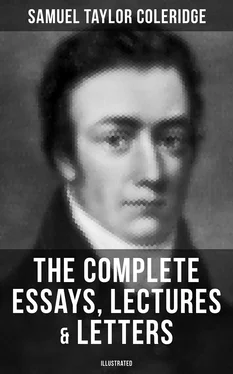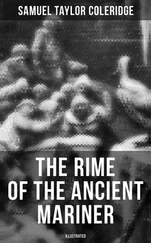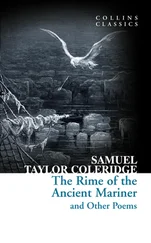…
“We afterwards ascended another hill, from the top of which a large plain opened before us with villages. A little village, Neuhoff, lay at the foot of it: we reached it, and then turned up through a valley on the left hand. The hills on both sides the valley were prettily wooded, and a rapid lively river ran through it.
So we went for about two miles, and almost at the end of the valley, or rather of its first turning, we found the village of Lauterberg. Just at the entrance of the village, two streams come out from two deep and woody coombs, close by each other, meet, and run into a third deep woody coomb opposite; before you a wild hill, which seems the end and barrier of the valley; on the right hand, low hills, now green with corn, and now wooded; and on the left a most majestic hill indeed — the effect of whose simple outline painting could not give, and how poor a thing are words! We pass through this neat little town — the majestic hill on the left hand soaring over the houses, and at every interspace you see the whole of it — its beeches, its firs, its rocks, its scattered cottages, and the one neat little pastor’s house at the foot, embosomed in fruit-trees all in blossom, the noisy coomb-brook dashing close by it. We leave the valley, or rather, the first turning on the left, following a stream; and so the vale winds on, the river still at the foot of the woody hills, with every now and then other smaller valleys on right and left crossing our vale, and ever before you the woody hills running like groves one into another. We turned and turned, and entering the fourth curve of the vale, we found all at once that we had been ascending. The verdure vanished! All the beech trees were leafless, and so were the silver birches, whose boughs always, winter and summer, hang so elegantly. But low down in the valley, and in little companies on each bank of the river, a multitude of green conical fir trees, with herds of cattle wandering about, almost every one with a cylindrical bell around its neck, of no inconsiderable size, and as they moved — scattered over the narrow vale, and up among the trees on the hill — the noise was like that of a great city in the stillness of a sabbath morning, when the bells all at once are ringing for church. The whole was a melancholy and romantic scene, that was quite new to me. Again we turned, passed three smelting houses, which we visited; — a scene of terrible beauty is a furnace of boiling metal, darting, every moment blue, green, and scarlet lightning, like serpents’ tongues! — and now we ascended a steep hill, on the top of which was St. Andrias Berg, a town built wholly of wood.
“We descended again, to ascend far higher; and now we came to a most beautiful road, which winded on the breast of the hill, from whence we looked down into a deep valley, or huge basin, full of pines and firs; the opposite hills full of pines and firs; and the hill above us, on whose breast we were winding, likewise full of pines and firs. The valley, or basin, on our right hand, into which we looked down, is called the Wald Rauschenbach, that is, the Valley of the Roaring Brook; and roar it did, indeed, most solemnly! The road on which we walked was weedy with infant fir-trees, an inch or two high; and now, on our left hand, came before us a most tremendous precipice of yellow and black rock, called the Rehberg, that is, the Mountain of the Roe. Now again is nothing but firs and pines, above, below, around us! How awful is the deep unison of their undividable murmur; what a one thing it is — it is a sound that impresses the dim notion of the Omnipresent! In various parts of the deep vale below us, we beheld little dancing waterfalls gleaming through the branches, and now, on our left hand, from the very summit of the hill above us, a powerful stream flung itself down, leaping and foaming, and now concealed, and now not concealed, and now half concealed by the fir-trees, till, towards the road, it became a visible sheet of water, within whose immediate neighbourhood no pine could have permanent abiding place. The snow lay every where on the sides of the roads, and glimmered in company with the waterfall foam, snow patches and waterbreaks glimmering through the branches in the hill above, the deep basin below, and the hill opposite.
Over the high opposite hills, so dark in their pine forests, a far higher round barren stony mountain looked in upon the prospect from a distant country. Through this scenery we passed on, till our road was crossed by a second waterfall; or rather, aggregation of little dancing waterfalls, one by the side of the other for a considerable breadth, and all came at once out of the dark wood above, and rolled over the mossy rock fragments, little firs, growing in islets, scattered among them. The same scenery continued till we came to the Oder Seich, a lake, half made by man, and half by nature. It is two miles in length, and but a few hundred yards in breadth, and winds between banks, or rather through walls, of pine trees. It has the appearance of a most calm and majestic river. It crosses the road, goes into a wood, and there at once plunges itself down into a most magnificent cascade, and runs into the vale, to which it gives the name of the ‘Vale of the Roaring Brook.’ We descended into the vale, and stood at the bottom of the cascade, and climbed up again by its side. The rocks over which it plunged were unusually wild in their shape, giving fantastic resemblances of men and animals, and the fir-boughs by the side were kept almost in a swing, which unruly motion contrasted well with the stern quietness of the huge forest-sea every where else.
…
“In nature all things are individual, but a word is but an arbitrary character for a whole class of things; so that the same description may in almost all cases be applied to twenty different appearances; and in addition to the difficulty of the thing itself, I neither am, nor ever was, a good hand at description. I see what I write, but, alas! I cannot write what I see. From the Oder Seich we entered a second wood; and now the snow met us in large masses, and we walked for two miles knee-deep in it, with an inexpressible fatigue, till we came to the mount called Little Brocken; here even the firs deserted us, or only now and then a patch of them, wind shorn, no higher than one’s knee, matted and cowering to the ground, like our thorn bushes on the highest sea-hills. The soil was plashy and boggy; we descended and came to the foot of the Great Brocken without a river — the highest mountain in all the north of Germany, and the seat of innumerable superstitions. On the first of May all the witches dance here at midnight; and those who go may see their own ghosts walking up and down, with a little billet on the back, giving the names of those who had wished them there; for ‘I wish you on the top of the Brocken,’ is a common curse throughout the whole empire. Well, we ascended — the soil boggy — and at last reached the height, which is 573 toises above the level of the sea. We visited the Blocksberg, a sort of bowling-green, inclosed by huge stones, something like those at Stonehenge, and this is the witches’ ball-room; thence proceeded to the house on the hill, where we dined; and now we descended. In the evening about seven we arrived at Elbingerode. At the inn they brought us an album, or stammbuch, requesting that we would write our names, and something or other as a remembrance that we had been there. I wrote the following lines, which contain a true account of my journey from the Brocken to Elbingerode.
I stood on Brocken’s sovran height, and saw
Woods crowding upon woods, hills over hills;
A surging scene, and only limited
By the blue distance. Wearily my way
Downward I dragged, through fir groves evermore,
Where bright green moss moved in sepulchral forms,
Читать дальше












